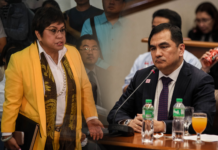PHILIPPINE journalism has now sailed on unchartered waters, triggered by two sportscasters, Marco and Maia.
GMA Network debuted Marco and Maia, surname-less and emotionless, on Sept. 24, generated using artificial intelligence (AI) to help navigate viewers for the 99th season of the National Collegiate Athletic Association.
Backlash ensued. The publicity material carrying the announcement has irked online users, amassing more than 70,000 “sad” reactions and 20,000 “angry” reactions on Facebook. Viewers felt that qualified journalism and communication students were being deprived of a chance to enter the broadcasting industry.
Prof. Rachel Khan, a journalism instructor at the University of the Philippines Diliman, described the move as a mere “gimmick.”
“[T]he one who designed it probably is hoping that there’s going to be an increase in ratings,” she told the Varsitarian. “That might be true for the first week, but when people just get bored, you know it’s not gonna last.”
One of the brains behind Marco and Maia, Aileen Rae Perez, assistant vice president and deputy head for social media of GMA Integrated News, declined to be interviewed but pointed to earlier statements defending the use of generative AI as a “groundbreaking project.”
“With the latest developments in generative AI, our team is always on the lookout for ways to deliver information in the most exciting and engaging manner,” Perez said in a press release on Sept. 23.
Aware of the negative public reception of the project, she appealed to give AI a chance.
“Instead of seeing creativity and innovation as a threat, we hope this initiative will start a healthy discourse on how generative AI could help news organizations improve the way we do modern journalism,” she said in another press release on Sept. 23.
AI has dominated much of the 2010s with the birth of digital assistant Siri, deepfake videos and self-driving cars.
AI has been present during that period in certain newsrooms, including the wire agency Reuters, where Pulitzer Prize-winning journalist Manny Mogato worked as a Manila-based correspondent from 2003 to 2019.
“[U]sing AI will improve, enhance siguro ‘yong delivery tsaka presentation ng news at a faster rate than ‘yong gumagawa ‘yong tao,” he told the Varsitarian.
(Using AI will probably improve and enhance the delivery and presentation of news at a faster rate than what humans can do.)
Khan said other media outlets are relying on AI for fact-checking.
“AI is already part of our work but only to enhance reporting, only to enhance news gathering and analysis,” she said. “And that’s a good use of AI because what it would take you to collate for over a week, AI can do in a few hours or even minutes, so why not use it?”
But the arrival of ChatGPT, a chatbot operated by OpenAI, in November 2022 came like a seismic wave for industries, including journalism, that were suddenly confronted with the question, “What’s next?”
Generative AI, the software engine behind ChatGPT, can answer questions and generate images that “demonstrated capabilities with such obvious and profound potential impact for journalism,” according to David Caswell, executive product manager at BBC News.
An analysis from SimilarWeb found more than 100 million users worldwide had accessed the tool just two months into its launch.
But Mogato claims that Philippine reception to AI is still lukewarm.
“I think […] Filipinos are not yet ready for this kind of technological development sa newsroom,” he said.
Human over robots
For Asst. Prof. Jeremaiah Opiniano, director of the Research Center for Social Sciences and Education, there must be a distinct line between AI and humans despite the former’s ability to lessen tasks.
“[H]uman news work dictates the pace of how AI-supported news work should lead to better and insightful journalism,” Opiniano, who also serves as executive director of the Institute for Migration and Development Issues, told the Varsitarian in an email interview.
“It may take time, or perhaps another ‘multiverse’ for Jarvis or Friday AI of the ‘Avengers’ to be like humans and produce the most darn best narrative journalism that balances good reporting tools – interviews, observation, data, background and context – with human creativity and storytelling.”
Only an AI built by a “super godlike genius” could ever imitate the functions of humans, Alexis Romero, a senior reporter at The Philippine Star covering the president, said.
“No matter what they do, no matter how advanced the technology will be, the AI will never have an intellect and will,” he told the Varsitarian.
That’s why the nuances of a sportscaster – brimmed with joy during victories and doused with disappointment during defeats – could never manifest with Marco and Maia, said Leo Laparan II, a copy editor at the Star.
“Yes, they can speak well. Pero kung mapapansin mo, walang kaemo-emosyon ‘yong pananalita,” he told the Varsitarian. “Ang tanging makakagawa lang niyan eh tayo mismong mga tao.”
(Yes, they can speak well. But if you will notice, they are emotionless when speaking. Only humans can do that.)
As a copy editor, Laparan proofreads articles sent to his desk every day, but the presence of digital typing assistants such as Grammarly – which was recently made available to all Thomasians – could upend his work.
Still, he feels optimistic that human intervention is still needed in his line of duty.
“Meron at merong mga tao or part ng audience na would prefer pa rin ‘yong traditional eh, hindi mawawala ang traditional,” Laparan, a journalism instructor at UST, said. “Pag nagkanda-leche-leche ang mundo, at lahat ng technology na ‘yan ay mawala, ang tanging mababalikan natin ay ‘yong traditional – manual reporting, manual copy-editing, ‘yong gagamitan natin ng mga copyediting symbols ‘yong mga story na ine-edit natin.”
(There will always be audiences who prefer traditional methods. If the world turns around and technologies suddenly vanish, the only thing we can go back to is manual – manual reporting, manual copy-editing and the use of copyediting symbols during editing.)
To adopt or not to adopt?
Newsrooms are now faced with a consequential decision: Will they adopt AI or not?
“I’m sure not all newsrooms will adopt the technology because some are still, you know, wary about it,” Romero said. “But […] you have to produce outputs that will differentiate you from AI.”
“You have to show them that human beings are capable of doing something that AI cannot. So, gandahan natin ‘yong istorya natin, lalagyan natin ng mas maraming human touch.”
(You have to show them that human beings are capable of doing something that AI cannot. So, we must produce quality stories with a lot of human touch.)
Khan said media organizations should already be drafting internal AI policies to make distinctions between when journalists are permitted to use AI tools and when they are prohibited.
“[T]hey should consider ethics,” she said. “AI should be used to enhance truthful news gathering rather than facilitate news manipulation. That is basic.”
“How they use the tools is really dependent on the medium because iba naman ang use ng print, iba ang use ng broadcast. But these are tools to enhance reporting. And that’s what they should figure out on their own.”
The National Union of Journalists of the Philippines (NUJP) called on newsroom managers to tackle the issue already as GMA’s move to introduce AI “does little to allay job security in media.”
“We urge colleagues to start these conversations in their workplaces if they aren’t happening already and ensure that issues on ethics and accountability are threshed out before policies are rolled out,” the group said in a statement on Sept. 24.
Layoffs at media behemoths have made journalists distraught for the past years, including ABS-CBN, whose shutdown in 2020 took more than 5,000 employees off the payroll; CNN Philippines, which was forced to downsize in 2021 to continue operations; and Philippine Daily Inquirer, which offered early retirement packages to journalists and columnists and scrapped the Metro section because of a “steady decline of the print newspaper industry largely due to the surge of the digital platform,” according to a memo issued by the human resources department; among others.
“While no journalist goes into this profession with illusions of wealth and comfort, the public service nature of media work should not mean free or poorly-compensated labor and taking unnecessary risks,” NUJP said on Sept. 20 in a statement.
For Romero, GMA could have resorted to Marco and Maia to avoid dealing with labor issues.
“Nando’n kasi ‘yong notion na baka if you have AI, it will not complain about working conditions, it will not demand a salary raise, it will not rant in social media,” Romero, a journalism instructor at UST, said. “It will just do whatever you ask, whatever your directives; it will just comply. Kahit gaano kadami ‘yan, hindi ‘yan magrereklamo.”
(There is a notion that if a company resorts to AI, it will not complain about working conditions, it will not demand a salary raise and it will not rant on social media. It will just do whatever you ask, whatever your directives; it will just comply. Whatever the amount of workload, AI will not complain.)
But he warned that overdependence on AI would compromise the standing of a journalist.
“[T]o ensure that reporters will still be properly compensated despite AI, reporters should be discouraged from using AI to generate content that they should have obtained through coverage or fieldwork,” he said. Ralent M. Penilla


















